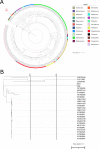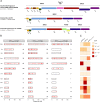Diverse Durham collection phages demonstrate complex BREX defense responses
- PMID: 37668405
- PMCID: PMC10537673
- DOI: 10.1128/aem.00623-23
Diverse Durham collection phages demonstrate complex BREX defense responses
Abstract
Bacteriophages (phages) outnumber bacteria ten-to-one and cause infections at a rate of 1025 per second. The ability of phages to reduce bacterial populations makes them attractive alternative antibacterials for use in combating the rise in antimicrobial resistance. This effort may be hindered due to bacterial defenses such as Bacteriophage Exclusion (BREX) that have arisen from the constant evolutionary battle between bacteria and phages. For phages to be widely accepted as therapeutics in Western medicine, more must be understood about bacteria-phage interactions and the outcomes of bacterial phage defense. Here, we present the annotated genomes of 12 novel bacteriophage species isolated from water sources in Durham, UK, during undergraduate practical classes. The collection includes diverse species from across known phylogenetic groups. Comparative analyses of two novel phages from the collection suggest they may be founding members of a new genus. Using this Durham phage collection, we determined that particular BREX defense systems were likely to confer a varied degree of resistance against an invading phage. We concluded that the number of BREX target motifs encoded in the phage genome was not proportional to the degree of susceptibility. IMPORTANCE Bacteriophages have long been the source of tools for biotechnology that are in everyday use in molecular biology research laboratories worldwide. Phages make attractive new targets for the development of novel antimicrobials. While the number of phage genome depositions has increased in recent years, the expected bacteriophage diversity remains underrepresented. Here we demonstrate how undergraduates can contribute to the identification of novel phages and that a single City in England can provide ample phage diversity and the opportunity to find novel technologies. Moreover, we demonstrate that the interactions and intricacies of the interplay between bacterial phage defense systems such as Bacteriophage Exclusion (BREX) and phages are more complex than originally thought. Further work will be required in the field before the dynamic interactions between phages and bacterial defense systems are fully understood and integrated with novel phage therapies.
Keywords: BREX; autographiviridae; bacteriophage; phage defense; phylogenetics.
Conflict of interest statement
The authors declare no conflict of interest.
Figures







References
Publication types
MeSH terms
Grants and funding
LinkOut - more resources
Full Text Sources
Molecular Biology Databases

